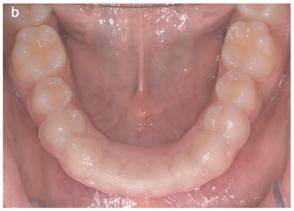Incisor irregularity and dental arch dimension changes in subjects with different severity of anterior crowding : A 37 - year follow up
What did the authors aim to do in this study?
What did the authors evaluate?
The study was carried out on 41 subjects which were then randomly divided into two groups based on the severity of crowding (Mild/Severe) according to the mandibular LII value at pretreatment (T1). The maxillary and mandibular LII, transversal and longitudinal widths were assessed at pretreatment (T1), post treatment (T2) and 37 - years post treatment (T3). This assessment was done by measuring the dental casts that were obtained from the patients at T1, T2 & T3. The measurements were taken in the maxillary and mandibular arches and they included LII as the quantitative method for assessing anterior irregularity.
The sum of the five linear displacements of the anatomic contact points of each incisor from the adjacent tooth's anatomic point represents the relative degree of anterior irregularity. In this study, the Little's irregularity index was modified to measure the irregularity of the maxillary anterior teeth. A virtual plane parallel to the occlusal plane was created to avoid the vertical difference in height between the displacements of the contact points. This plane was defined as the one passing through an idealized contact point between the incisors and the mesio-palatal cusp tips of the first molars (Fig 1 A & B).
The intercanine width : the distance between the cusp tips of the permanent canines; The interpremolar width: the distance between the buccal cusp tips of the first or second premolars; The intermolar width : the distance between the mesiobuccal cusp tips of the first molars. When the dental cups tips presented signs of wear in post treatment follow-up measures (T3), the reference point of the center of the worn cusp was taken. The arch length : the distance from the lingual contact point between the central incisors to a line connecting the mesial contact points of the first molar from one side to the other; The arch perimeter: the sum of the segments from mesial permanent first molar contact to the distal canine and from the distal canine contact to the mesial central incisor contact on both sides (Fig 2 A & B).
What did the authors find?
The groups presented similar behaviour for all stages of maxillary and mandibular arch dimension changes. Maxillary irregularity was corrected in both groups after treatment, and the alignment was acceptable in the long term. In the mild group, the mandibular incisor irregularity returned to pretreatment values in the long term.In the mild group, the mandibular incisor irregularity returned to pretreatment values in the long term. The mandibular LII increased in the severe group but did not return to pretreatment values in the long term.
What did the authors conclude?
· The arch dimension stability was similar in cases with initial mild and severe anterior irregularity.
· The mild crowding group presented proportionally more relapse of mandibular incisor irregularity than the severe crowding group in the long term.
· Even so, the correction of mild and severe crowding with the extraction of 4 premolars showed satisfactory results in the long term, even with the presence of maturational changes and relapse.




Comments
Post a Comment